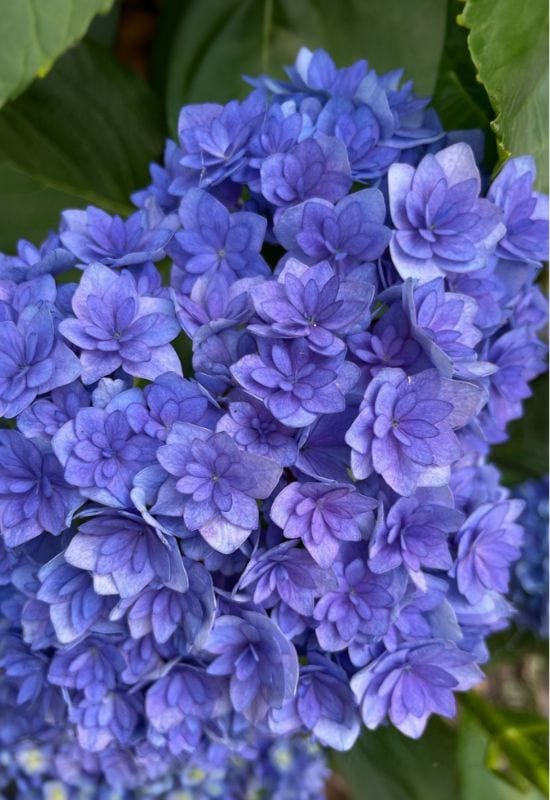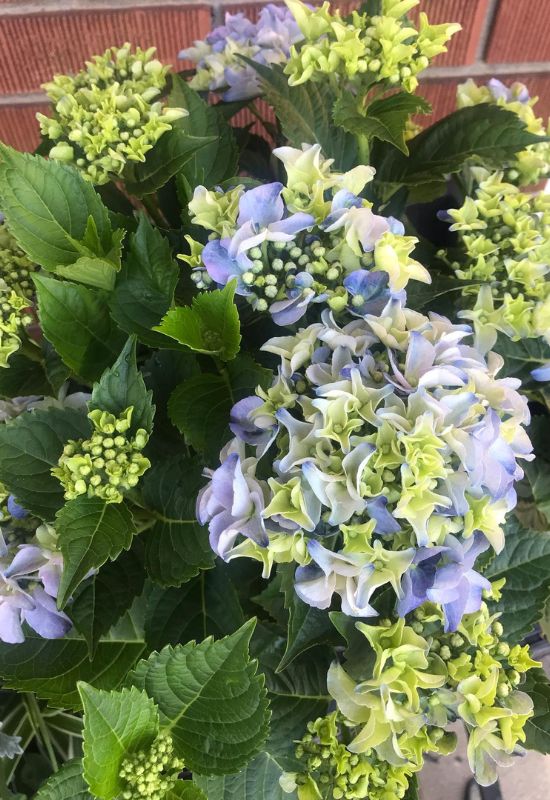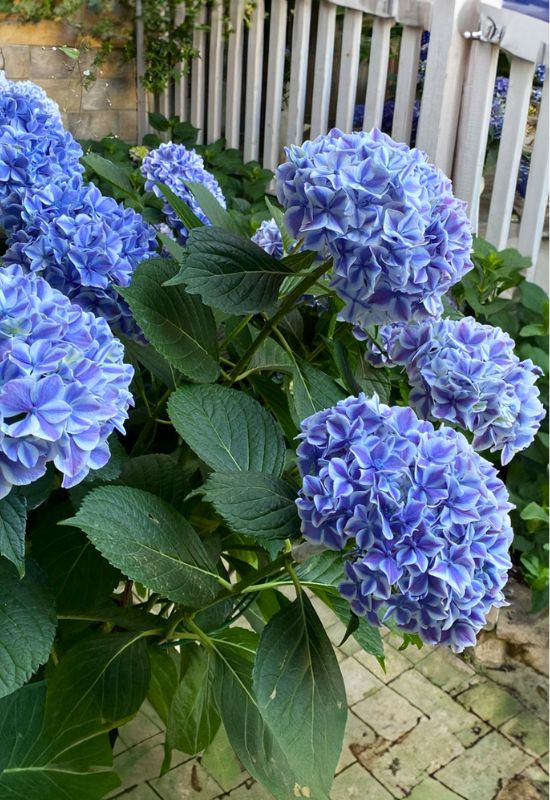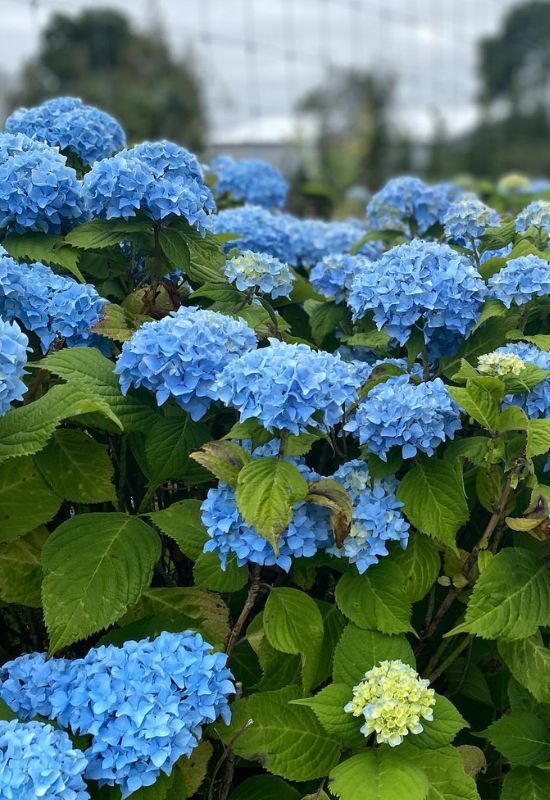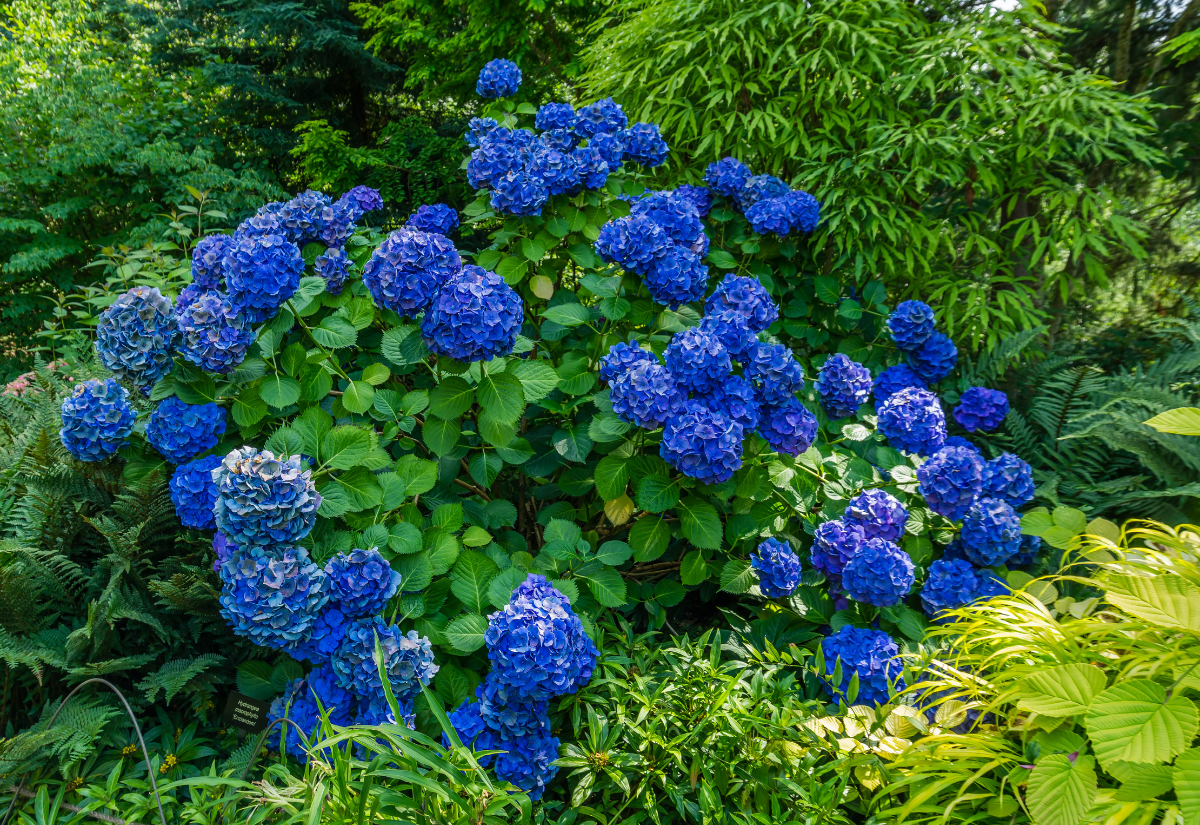
From sky blue to light pastel, from intense and dark to almost purple, blue hydrangeas are always highly sought after in our gardens. Their massive sky-colored flower clusters, reminiscent of clouds fallen from the sky, are adored worldwide.
These plants can showcase breathtakingly soft and calming blooms, suitable for sunny yards or shaded, fresh hedges. They also thrive in containers or when mass-planted, creating a vista of cobalt, azure, or turquoise.
Fast growing and vigorous shrubs, blue hydrangeas can transform your garden with their romantic, old world and also natural look, but they don’t pull any punch also when it comes to their massive, globular and literally spectacular inflorescences. Easy to grow and shade tolerant, they can bring the sky to earth, and bring bliss to your summer garden.
But there is something important we need to learn first, because blue hydrangeas can be quite surprising, and you want to make sure you get the right color first…
For a hydrangea to showcase those stunning blue blossoms, you must plant it in acidic soil, typically with a pH between 5 and 6. But if the soil conditions aren’t just right, or if they change over time, those vibrant blue hues can shift. Instead of the desired azure, you might end up with pink or purple flowers.
If you’re eager to explore and experience the most divine blue-blooming hydrangea varieties on Earth, join us on this gardening journey!
We’ll introduce you to the best varieties for that ‘True’ blue bloom, and we’ll share the secrets to maintaining their unique hues year after year.
How to Make Sure that Your Hydrangea Is Really Blue
In fact, I don’t want you to have a little surprise and even be disappointed, and plant a blue hydrangea but see it blooming with pink flowers instead! Yes, because the actual shade of the blossoms will depend on the soil pH!
When the soil is acidic, ideally with pH from 5.0 to 5.5, the blooms are really blue, but as it passes 5.5, they will turn to violet and mauve, and when it gets to neutral (7.0), then mildly alkaline, the flowers will literally turn pink!
Now, hydrangeas prefer soils that are at least mildly acidic in general (under 6.5), because above that they suffer from iron deficiency. And the pigments change color, as you see…
So, if your soil is not acidic, you will need to make it so. Adding sulphur is the most common way, but you can also do it by replacing it (maybe lining it, as we do with Rhododendron), and fresh coffee, black tea and lemon can give you natural ways of acidifying the topsoil.
So, now you know how to keep your hydrangeas flowering in sky or cobalt blue, we can meet the first variety on our list!
15 Blue Blooming Hydrangeas for a Garden in the Sky
And here they are, for large or small gardens, these heavenly hydrangeas have lots of blooms in blue, to see the sky even on a cloudy day!
1: ‘Big Daddy’ Bigleaf Hydrangea (Hydrangea macrophylla ‘Big Daddy’)
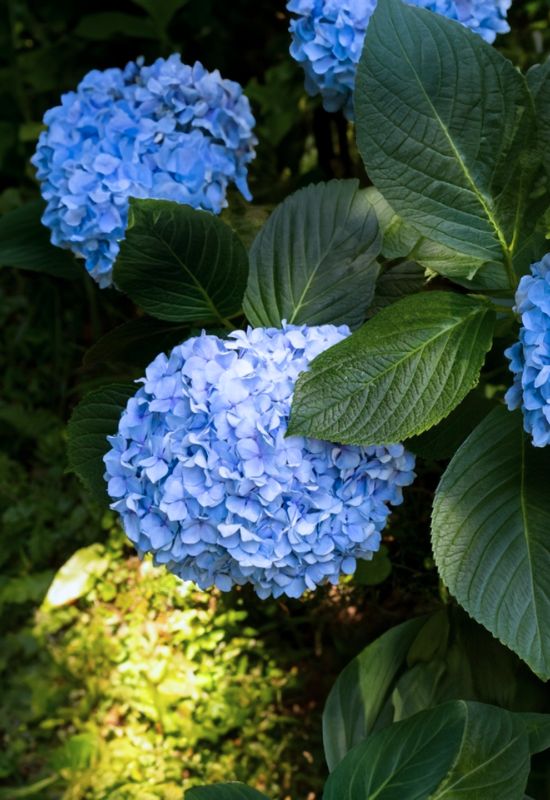
We can tale flight into the heavens of traditional looking garden with a real giant, the “Boeing 747” of blue colored hydrangeas… Yes, because ‘Big Daddy’ bigleaf hydrangea has massive globular, almost spherical inflorescences are really massive, reaching a jaw dropping 14 inches in diameter (35 cm)! But their huge size is all but daunting…
In fact, you will get lost in its very generous floral display, which can almost fill the whole shrub at peak times, because it has the exact, bright but soft, color of the sky, in a vibrant but pastel tonality… The many flowers that pack the clusters have four diamond shaped petals, and if you look closely, you may even see shy hints of violet, depending on the soil pH.
And this breathtaking spectacle will be with you from early summer to early fall, bringing freshness to your hot days with its dreamy personality. In fact, it will blossom first on old growth, and then again on new growth, with its dense mophead corymbs. While the blooms are on a massive scale, it is indeed a medium sized leafy shrub, with broad and bushy, quite glossy and on the dark side of green for this genus.
Maybe one of the most spectacular blue hydrangeas you can ever grow in terms of blooms, ‘Big Daddy’ can take center stage as a specimen shrub, or you can have it as a heavenly foundation plant next to your home, but it can also bring the sky to informal hedges, or even in containers. And yes, for cut flowers it is really magnificent as well! It is also one of the best for deep shade.
2: ‘Cityline’ Hydrangea Bigleaf (Hydrangea macrophylla ‘Cityline’)
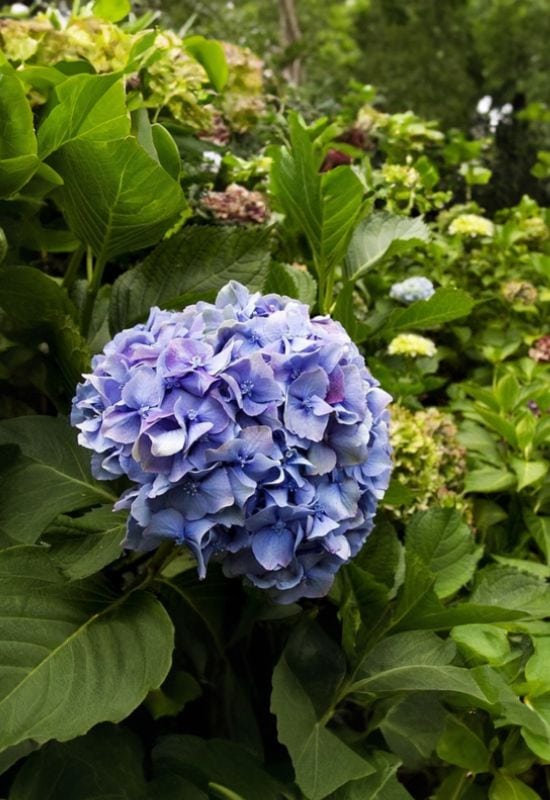
For a compact shrub, one you can easily grow in containers, you may wish to have a look at ‘Citilyne’ bigleaf hydrangea, which only grows to 3 feet tall and in spread (90 cm). But don’t be deceived by its diminutive size, it will still produce lovely spherical clusters of blue flowers all the way from early summer to early fall.
These corymbs are not particularly big, true, coming in at 4 to 5 inches across (10 to 12.5 cm), but they are fully packed with lots of florets, and the bloom is quite generous indeed. But these blossoms have yet another quality to grace your garden…
They reach rally deep shades of our color, touching notes of lapis, cobalt and even admiral blue! And they are quite vibrant as well, so, you will get a very intense effect. On the other hand, it will do the same on the opposite range, and turn rosy pink in alkaline soil… But once you have taken the right precautions, you can enjoy its long lasting floral display set on a mound of very dense foliage, which too has a flair for depth, as it is of a dark cadmium to British racing green!
‘Citilyne’ is ideal for small gardens, terraces and containers, but its intense blue blossoms and dark green leaves can add depth also to flowering and herbaceous borders and even at the back of flower beds. It is also a particularly healthy and sturdy dwarf shrub variety, and, despite being modest in size, the blooms will also give you lovely bouquets if you cut them and take them indoors.
3: ‘Sumida no Hanabi’ Bigleaf Hydrangea
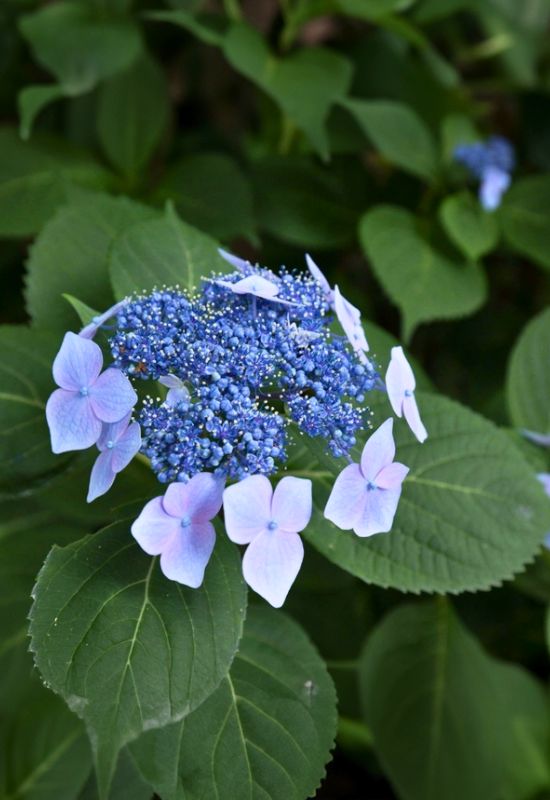
And now we meet a really unusual variety of bigleaf hydrangea, with a very strange name as well: ‘Sumida no Hanabi’ bigleaf hydrangea, which means “fireworks of the Sumida river” in Japanese. And you will understand why, when you look at its inflorescences…
In fact, the corymbs have large start shaped double flowers, which are sterile, at the edges that hang on long pedicles all around the really flat clusters, and these will take on a very pale, pastel sky blue color… But in the center, you will see really tiny, almost invisible still double and fertile florets instead, but instead of being light and breeze, these microscopic blossoms have a very vibrant and bright, strong ultramarine shade, with some turquoise notes…
These open and airy clusters are about 10 inches across (25 cm) and they will come from early summer to fall. Set against the glossy and rich green, lush foliage with serrated margins, this floral display adds a lace like appearance to a dense and medium sized shrub. Its surprising beauty has not passed unnoticed though, as it has won the prestigious Award of Garden Merit by the Royal Horticultural Society!
‘Sumida no Hanabi’ will add a touch of celestial elegance with its unusual blooms to your garden where you can grow it in hedges or as an accent shrub, but it is also small enough to fit in a container. Suitable to traditional and informal landscapes, it will work well also in an orientally styled green space.
4: ‘Blue Heaven’ Bigleaf Hydrangea (Hydrangea macrophylla ‘Blue Heaven’)
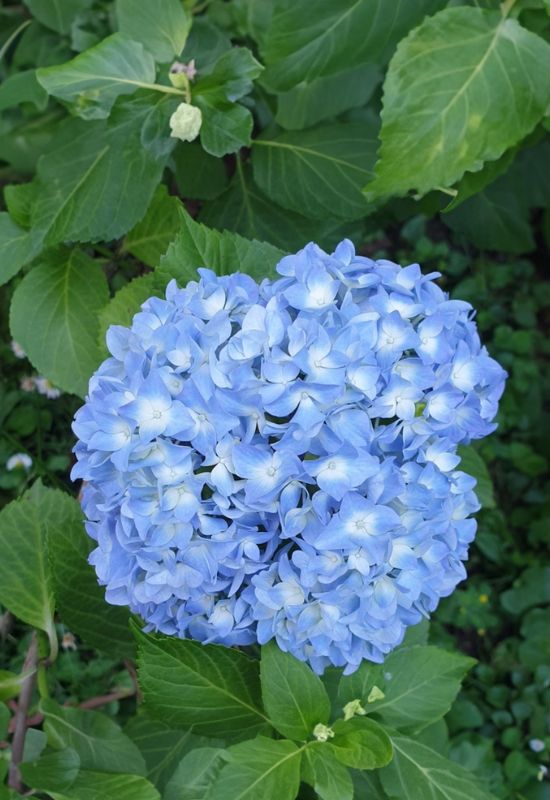
Of course we could not leave out a variety called ‘Blue Heaven’ from our selection! But it is not just for its name; in fact, this bigleaf hydrangea has a very special quality indeed! It is a massive marathon bloomer! Expect to see the round and dense flowery clusters on both old and new growth and even if the buds have suffered from some winter damage!
And expect this floral display to last all the way from early summer to the first day of frost as well! The packed corymbs will reach about 5 to 6 inches across (12.5 to 15 cm) and they will come in waves, but they have yet another asset to offer you and your garden…
They can reach really intense notes of blue, including lapis and cobalt! Vibrant in tonality, the blossoms are also rounded in shape, with four broad petals each. And if this was not enough to convince you, consider that the foliage is super lush and bushy on this medium to modest sized shrub, rich green and semi glossy and with elegant serrated margins.
One of the best varieties of bigleaf hydrangea for intense sky colored blooms to last till the end of fall, ‘Blue Heaven’ is also perfect for foundation planting, as well as in hedges or containers. If you mass plant it, your garden will look like a sunny sea till frost!
5: ‘Cityline Mars’ Bigleaf Hydrangea (Hydrangea macrophilla ‘Cityline Mars’)
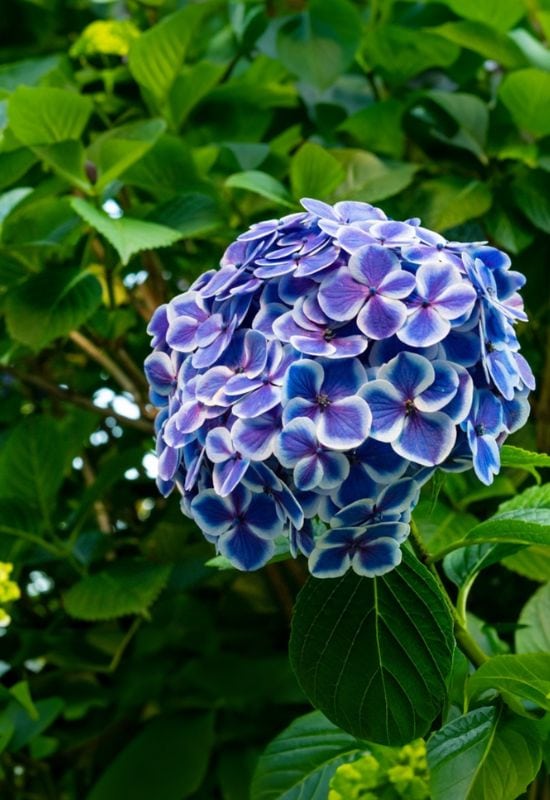
And here’s another small variety of bigleaf hydrangea; however, this time, it comes with a twist, and it is called ‘Cityline Mars’. And what is this unusual trait? It is bicolor, of course!
The flowers have really broad petals that give them a round shape, and the margins are white, but then they start shading to blue, as if painted with a crayon, and this color intensifies more and more as you get to the center. There, it can hit very vibrant tonalities, depending on the soil pH, from cobalt to violet (in neutral soils) or ross (in alkaline environments).
The clusters are round, almost spherical and about 6 inches across (15), really densely packed with blooms, and they come repeatedly from early summer to early fall. Coming on sturdy stems, these corymbs also benefit from extremely lush and lustrous, very glossy rich green and healthy leaves with a very finely grooved surface and regular serration at the margins. And all this will happen on a little shrub that reaches only 3 feet in height and in spread (90 cm)!
‘Cityline Mars’ is a really striking bigleaf hydrangea variety to grow in containers, on a terrace or patio, but it will also bring vibrant blue and white colors to your garden in foundation planting, or in flowering hedges, and you could have it as an accent shrub as well.
6: ‘Summer Beauty’ Bigleaf Hydrangea (Hydrangea macrophylla ‘Summer Beauty’)
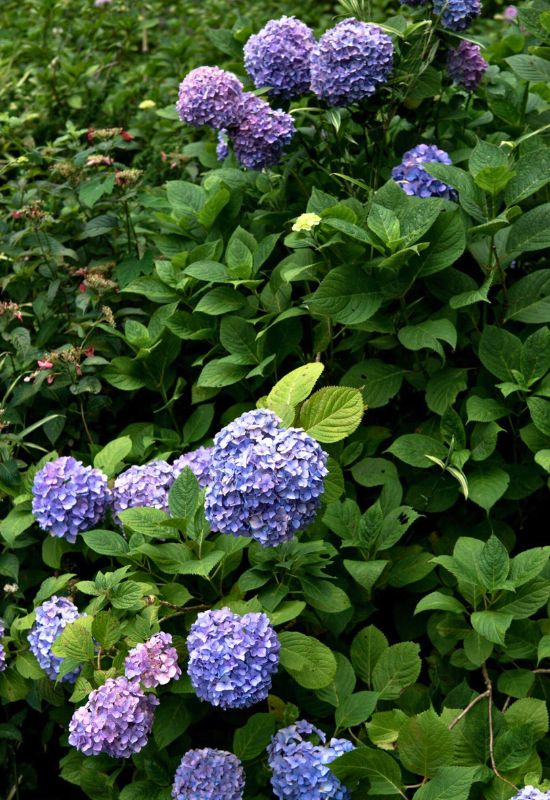
Just a bit bigger than ‘Citilyne Mars’, bigleaf hydrangea ‘Summer Beauty’ is a really floriferous variety for your garden, or terrace if you wish. Its blossoms come in globular clusters, starting in early fall, opening on both old and new growth, and they almost cover the whole shrub when this sky inspired floral spectacle is at its most vigorous peaks…
The flowers that fill the corymbs start off in a vibrant and bright shade of cobalt to cyan, and then they fade off slowly to lighter, pastel tonalities of the same color. Despite the small size of the plant itself, these clusters can be anything between 4 and 6 inches across (10 to 15 cm). When you can see the foliage under the blooms, you will also appreciate its rich but bright to mid green and semi glossy foliage, with ovate rather than lance shaped leaves, and very finely serrated margins.
Ideal for a small garden or containers, ‘All Summer Beauty’ will give you very intense and generous blue blossoms also next to your home or walls as a foundation plant, but it can also take part in flowering hedges as a small shrub. You can also mass plant it for a big blue spectacle or take it indoors as cut flowers.
7: ‘Passion’ Bigleaf Hydrangea (Hydrangea macrophilla ‘Passion’)
For a really spectacular effect, you should definitely have a look at ‘Passion’, a double cultivar of bigleaf hydrangea… And you won’t need to wait for long to see its amazing blossoms, because it will start opening its buds in mid spring, and it will continue till early fall!
The flowers have really elegant elongated and softly but clearly pointed tips, and they form really decorative rosettes, almost like multi rayed stars… As this show starts, only some heads open, and it may look like a lacecap variety, but as time goes by, all the blooms unfold, and some are bigger, and usually paler, and others, concentrated in the center of the cluster, are smaller but more intense in color.
The exact shade will depend on the soil’s acidity, but it can range from sky to almost cobalt, and the same is true if you grow it in an alkaline environment, but on the pink scale. Packing large round clusters that reach 8 inches across (20 cm), they come on sturdy stems on top of a lush mound of rich to dark green and finely serrated leaves.
An ideal shrub to grow as an accent plant, blue flowering ‘Passion’ is a really rewarding double variety of bigleaf hydrangea, with an extremely long blooming season also for foundation planting, in a shady herbaceous hedge or for cut flowers.
8: ‘Lanarth White’ Lacecap Hydrangea (Hydrangea macrophylla ‘Lanarth White’)
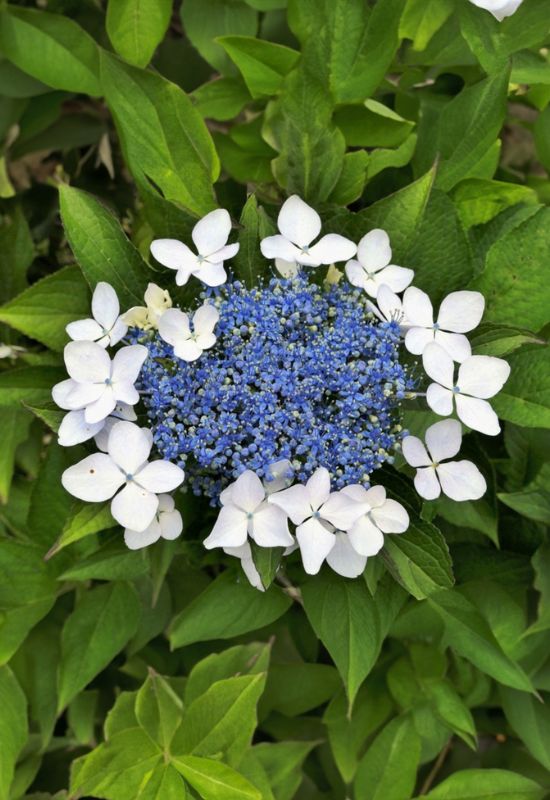
No, I didn’t get the color wrong… You see, ‘Lanarth White’ is a hydrangea variety that belongs to the lacecap group, and this has a very special quality… The corymbs are usually flat, and they have two types of flowers in them… The sterile blooms are bigger and they grow around the edges of the cluster, and in our cultivar, they are almost star shaped, with four pointed petals and, yes, white…
But it is the fertile little florets that cluster at the center of the inflorescence that can be blue, even in deep lapis shades, but again, this will depend on your soil’s pH. So, what you get is a very elegant, light and indeed lace like blossoms that start opening in early summer and keep coming like butterflies to early fall, with candid the beauty of snow and sky…
They are nog as showy as with other bigleaf hydrangeas, but you should not underrate their decorative value. The leaves are not very big, but they are lush and rich green with and semi glossy, and the fill this medium small shrub with fresh foliage. And the exquisite personality of this bushy but refined beauty has gained it the famous Award of Garden Merit by the Royal Horticultural Society!
‘Lanarth White’ lacecap hydrangea is the ideal variety to grow if you want elegant blossoms in blue and white, rather than an overwhelming floral display, and it will look great as a backdrop to a flower bed, or in a herbaceous border, next to walls, or even in containers…
9: ‘Early Blue’ Bigleaf Hydrangea (Hydrangea marcophylla ‘Early Blue’)
Yes, you guessed it! I would like to show you ‘Early Blue’ bigleaf hydrangea for one main reason… As its name suggests, it is an early starter, and in fact, it will open its first blooms in mid spring, but it also has the stamina to keep repeating its floral spectacle till early fall!
But this is not the only reason to grow it in your garden… In fact, its corymbs are really globular, almost like perfect spheres and 4 to 6 inches across (10 to 15 cm), but also particularly full. And particularly blue, hitting notes or sapphire, lapis and very vibrant and bright tonalities indeed.
But this, of course will depend on your soil pH, as you know. But there is yet another trait that makes it really special… The flowers have broad petals, but if you look closely at the margins you will notice that they are gently dented, almost frilled! Floating on top of a semi glossy compact mound of rich to dark green leaves, its blossoms can almost cover the whole shrub at times.
‘Early Blue’ is a fairly small bigleaf hydrangea variety as well, so you can enjoy its super long lasting blue blossoms even in a modest green space or on a terrace, in a container, but you also also mass plant it, maybe next to a wall, to have the color of the sea and sky all through the season.
10: ‘Tuff Stuff Ah-Ha’ Mountain Hydrangea (Hydrangea serrata ‘Tuff Stuff Ah-Ha’)
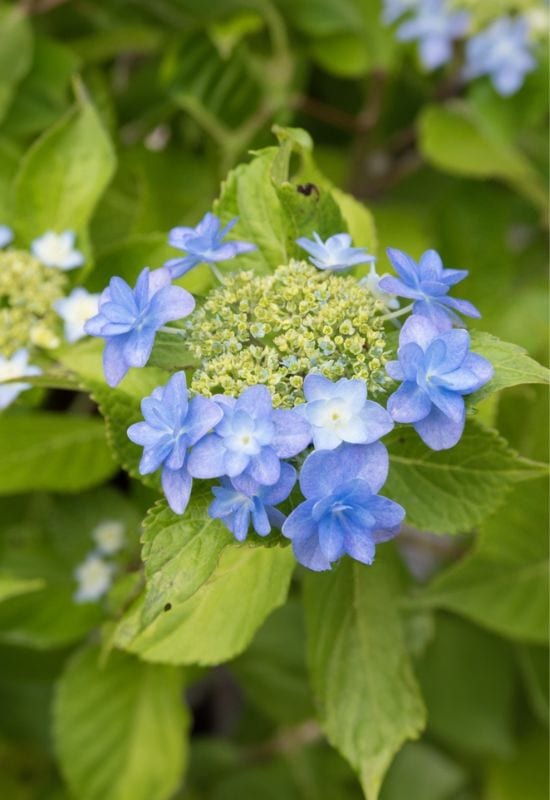
‘Tuff Stuff Ah-Ha’ has a funny name, but also a cheerful and playful personality. In fact, its inflorescences like to mix and match shapes and shades… Starting in early summer, in fact, the sterile blossoms at the margins open, and they have long and pointed petals, elliptical and looking like the rays of stars.
And these are usually pastel blue in color, though, again, it all depends on the soil pH. But at this early stage, the small and fertile florets are still in bud, and they have a lovely bright green color. Then they blossom as well, and they display deeper tonalities of blue, all the way to sapphire…
In alkaline soil, they will go on the pink range, as you know… These clusters are about 4 to 6 inches across (10 to 15 cm) and they blossom till fall a small shrub. But being a mountain variety, the leaves have very deeply serrated leaves, and in our case, they are semi glossy and quite dark as well.
If you like color combinations, you can have this little blue and green little shrub in containers on a patio or terrace, but also at the front of herbaceous flowering borders or, why not, in a perennial bed…
11: ‘Zorro’ Lacecap Hydrangea (Hydrangea macrophylla ‘Zorro’)
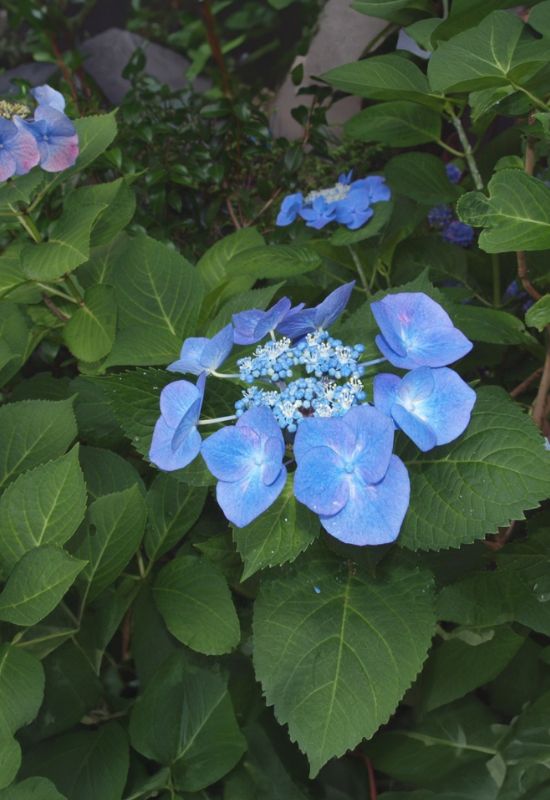
‘Zorro’ is a very popular and compact variety of lacecap hydrangea, and, in fact, it has won the much coveted Award of Garden Merit by the Royal Horticultural Society! Four broad but pointed petals unfold as the first sterile flowers blossom, in early summer, and they will have a color that ranges from sky to sapphire blue, and they look a bit like butterfly wings.
The little florets that cluster in the center of the cyme are white when they are still in bud, but they will soon blush to blue as well as they bloom, but they will also display lovely white filaments in their center… About 4 to 5 inches across, these flat topped inflorescences look like landing lads for pollinators, and in fact they will attract them… Coming on strong stems that can be purple in some cases, this floral display shines with peaceful light on a dense backdrop with dark and glossy green leaves.
Another excellent variety for small gardens, ‘Zorro’ lacecap hydrangea will bring elegance and blue notes to your summer days also in containers or as part of a herbaceous border. If mass planted, it can give you a really fine and textured display.
12: ‘Spike’ Bigleaf Hydrangea (Hydrangea macrophylla ‘Spike’)
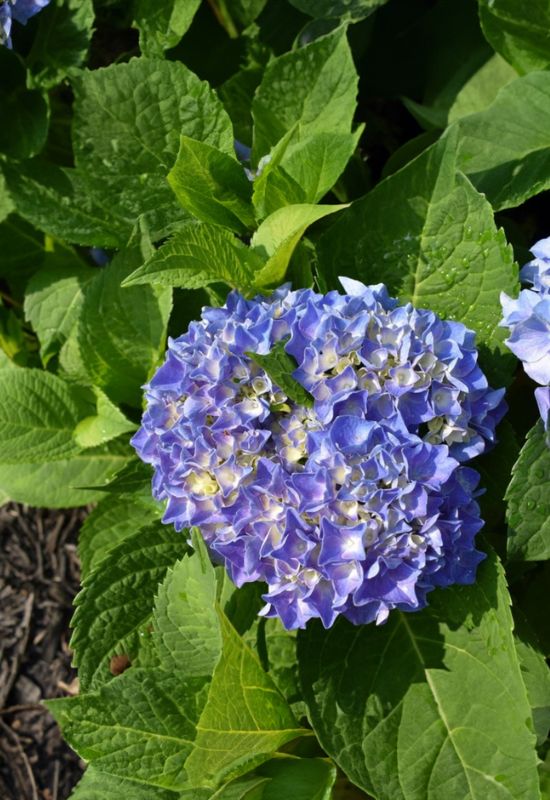
Now, imagine mixing the color of the sky with the waves of the sea… What you get is ‘Spike’ another compact variety of bigleaf hydrangea for your garden or patio… Yes, because the corymbs are round, spherical and about 4 inches across (10 cm) and starting their floral display in early summer, then repeating till early fall.
And, so far, it does not differ too much from other varieties. But if you look at the actual flowers themselves, you will notice that their four broad petals are, indeed, quite wavy, adding elegant and harmonic movement to the blooms, and they also tend to stay rather cupped, instead of spreading flat out, sometimes with a cream white center.
This forms a very sinuous and almost frilly cluster with an old world look, and a natural bouquet, which rests on a dense mound of lush, semi glossy and bright to mid green leaves.
Ideal for an extra touch of blue in a traditional looking garden, you can grow ‘Spike’ bigleaf hydrangea for foundation planting next to walls or your home, or as a specimen shrub, or even mass plant it and have a sea of blue blossoms in a herbaceous hedge. But it will fit in a container as well, or in a vase as a cut flower.
13: ‘Peppermint’ Bigleaf Hydrangea (Hydrangea macrophylla ‘Peppermint’)
Just the name gives you a sense of freshness… ‘Peppermint’ is a really decorative variety of bigleaf hydrangea, which plays with colors with the expertise of a consummate artist. You will notice it when the first blooms open in its round, globular corymbs, because they are quite extraordinary, often asymmetrical and reminiscent of butterfly wings, or even orchids, with bigger and smaller but harmonic petals! And on these flowers, you will notice a shade of blue that ranges from azure to sky or sapphire (again, depending on soil pH) or even violet (in close to neutral environments), but fading to white at the margins. These bicolor blossoms will come again and again in clusters of about 4 to 6 inches across (10 to 15 cm) till fall, and quite generously as well. A bigger shrub than many others we have seen so far, it also boasts a really lush and healthy set of dark and glossy, clearly serrated leaves.
‘Peppermint’ bigleaf hydrangea can be a blue and white (and deep green) accent shrub in your garden, or it could form a really colorful hedge if you mass plant it or mix it with other shrubs, and it will also give you a really good production of cut flowers for your indoor spaces.
14: ‘Emotion’ Bigleaf Hydrangea (Hydrangea macrophylla ‘Emotion’)
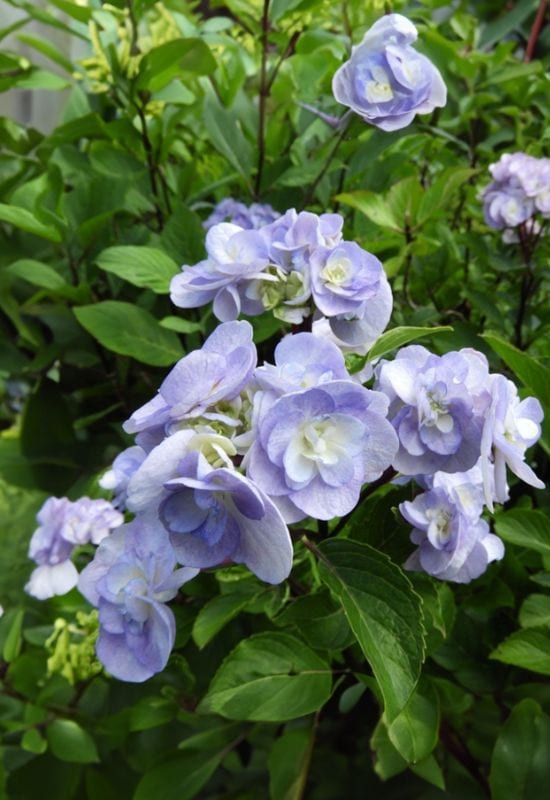
‘Emotion’ is a loved pink variety of bigleaf hydrangea, and usually grown for this color. But it doubles perfectly well into a blue beauty if you grow it in acidic soil (or violet in neutral environments)… In fact, it has quite large flowers, that range between 1 and 2 inches across (2.5 to 5.0 cm), and they are double as well, forming lovely rosette like displays, with bigger almost triangular petals at the back, and smaller ones in the center.
But the blooms do not all open at the same time, so, the large clusters look like lacecap at first, till all the buds open to fill the corymbs, which range between 6 and 8 inches across (15 to 20 cm).
This little shapeshifting spectacle will start early as well, in mid spring, and it will continue through the summer months and into early fall, with pastel shades of light sky blue, but sometimes darkening to more intense sapphire and even cobalt tonalities. But the luminous blossoms also benefit from the particularly dark and glossy, lush and dense foliage that form a contrasting and shrubby backdrop.
Ideal as an accent shrub, ‘Emotion’ and its blue (to pink) double flowers can also brighten up your flowering hedges, or you could grow it next to walls and your home for foundation planting, or, why not, even in a large container on a terrace or patio, for a marathon bloom throughout the whole season.
15: ‘Nikko Blue’ Bigleaf Hydrangea (Hydrangea macrophylla ‘Nikko Blue’)
We conclude our flight with a real classic of blue hydrangea, ‘Nikko Blue’. An heirloom bigleaf variety from Japan, it is also one of the most popular around the world and a best seller…
And of course it is, with its large and packed corymbs, round like mounds of bright jewels, that start in early summer and will keep your garden filled with peaceful energy till the end of the sunny season…
The flowers are quite large over 1 inch across (2.5 cm) and showy in themselves, with their four diamond shaped petals that form stars when they spread out flat. And they will grace your days with their luminous sky blue to sapphire color, which is quite vibrant indeed, and sometimes, the blooms display a white blotch at the center…
Between 5 and 6 inches across (12.5 to 15 cm), these clusters can take your breath away with their heavenly floral display set on a medium to large shrub of rich green, pointed and serrated leaves.
‘Nikko Blue’ has set the standard for blue hydrangeas worldwide, and if you grow it for foundation planting, as an accent or specimen shrub, in flowering hedges or and herbaceous borders, you will have a heavenly presence and a bit of history in your garden, and you can take all this indoors in a decorative vase as well.
Blue Hydrangeas for a Heavenly Garden
Now we can land, after having flown among the clouds of flowers in the blue skies of leafy and blooming hydrangeas… And now you are back on Earth, it is up to you to choose which flowering beauty you want to grow in your garden, and have a piece of heaven for yourself and your family!

Written By
Amber Noyes
Amber Noyes was born and raised in a suburban California town, San Mateo. She holds a master’s degree in horticulture from the University of California as well as a BS in Biology from the University of San Francisco. With experience working on an organic farm, water conservation research, farmers’ markets, and plant nursery, she understands what makes plants thrive and how we can better understand the connection between microclimate and plant health. When she’s not on the land, Amber loves informing people of new ideas/things related to gardening, especially organic gardening, houseplants, and growing plants in a small space.

